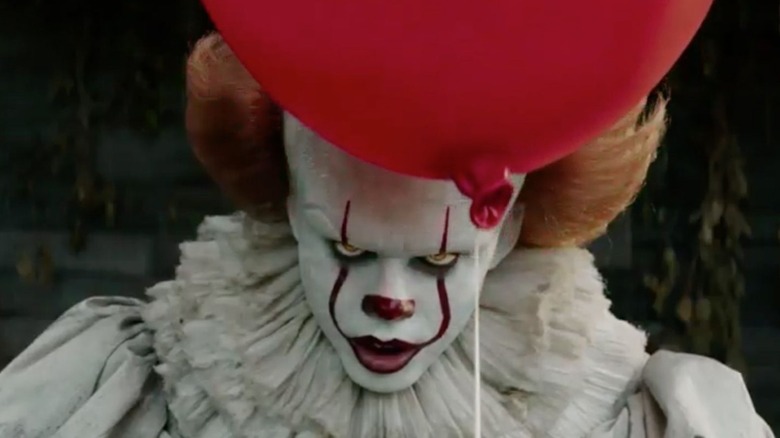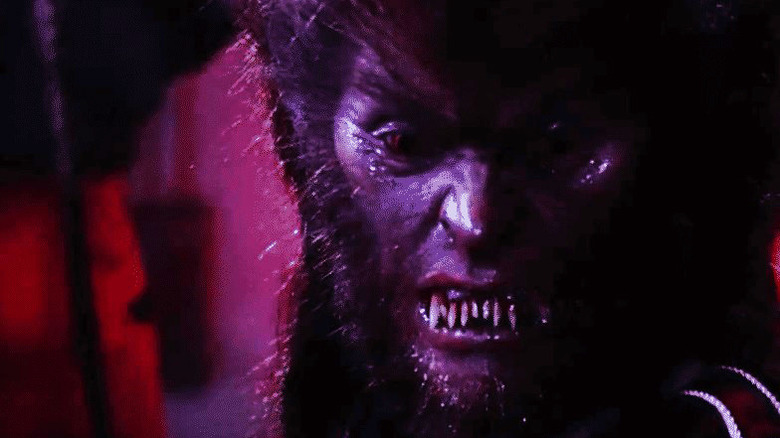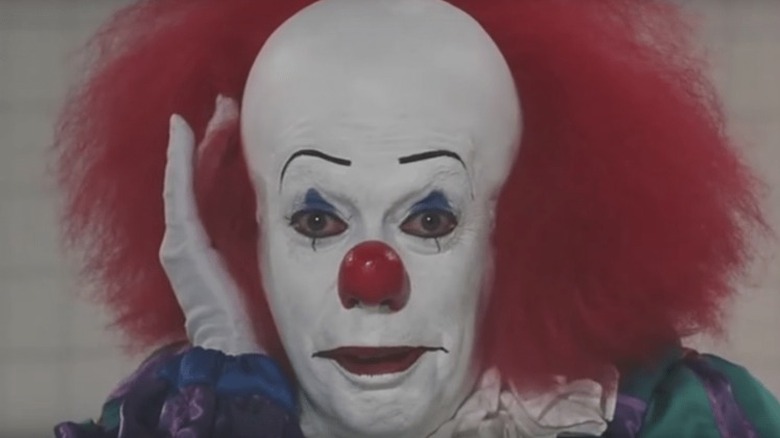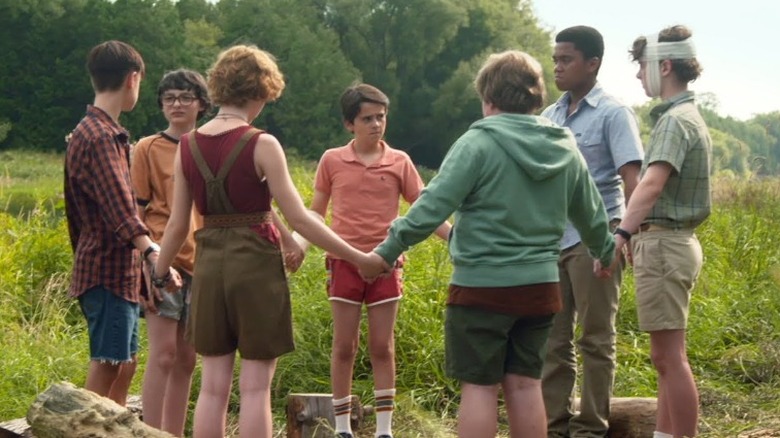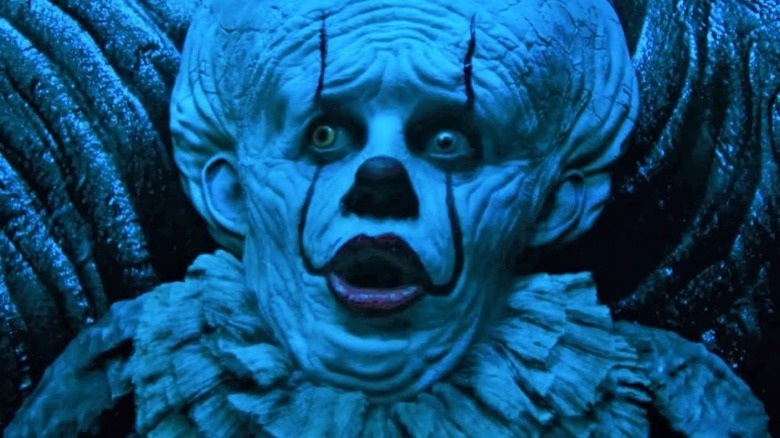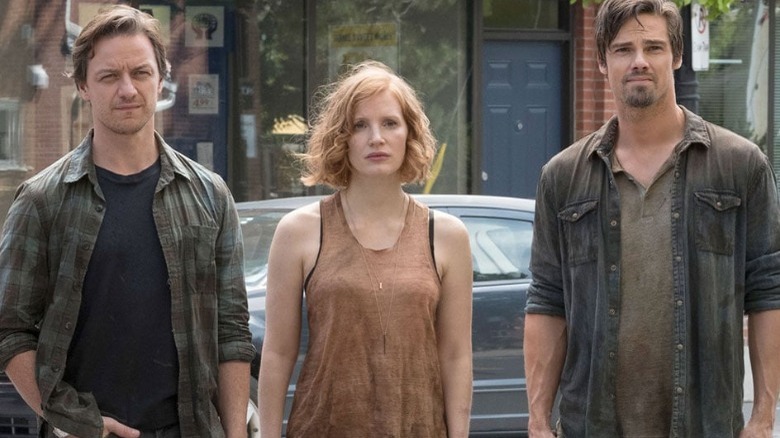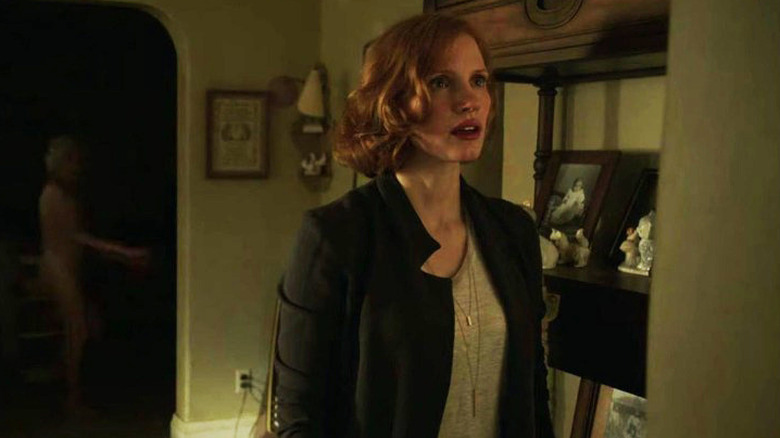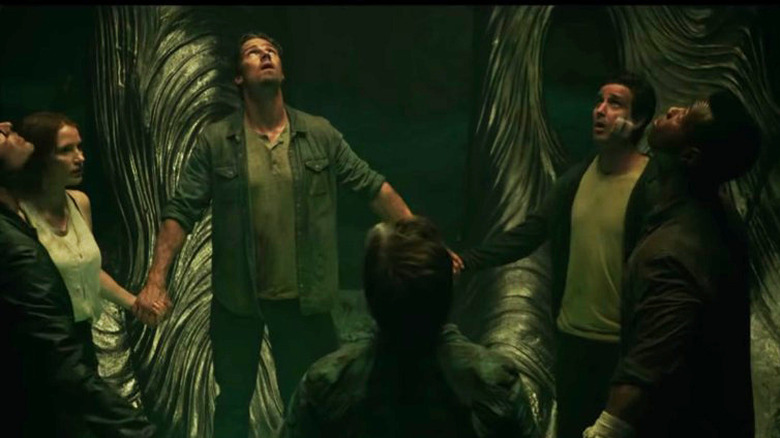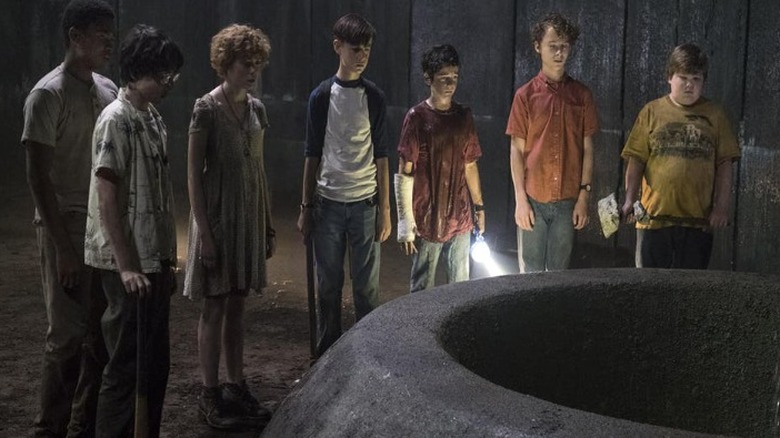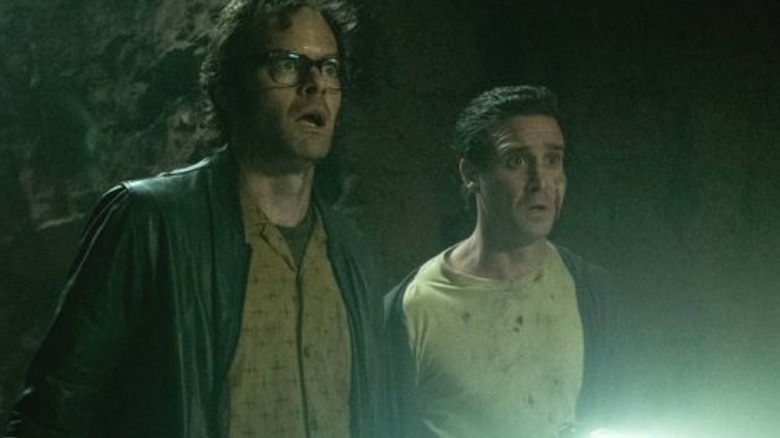All Of Pennywise's Weaknesses Explained
Stephen King's "It" is practically a horror phenomenon. Arguably his most famous work, it has been adapted to screen twice, the latter of which was helmed in two parts by "Mama" director Andy Muschietti. By sheer serendipity or perhaps the convergence of powerful horror forces, Muschietti's adaptation shattered expectations, and it still currently sits as the highest-grossing horror movie of all time (unadjusted for inflation). Even Tommy Lee Wallace's two-part television adaptation is well-loved, not the least of which is on account of a terrifying performance from Tim Curry as Pennywise, the source material's chief antagonist.
King himself notes inspiration from a car breakdown in Boulder, Colorado, and the story of "The Three Billy-Goats Bluff," noting his desire to write a novel with sewers, trolls, and a ricocheting effect between childhood and adulthood. Thus, "It," and Pennywise, were born. Better still, Pennywise's chief form is that of a dancing clown, easily tapping into ubiquitous and longstanding fears of clowns in all their big shoe, puffy clothes glory. For as frightening as Pennywise is, however, he isn't invincible. Here are 10 of Pennywise's weaknesses you may not have known about.
Silver slugs
A core component of Pennywise's identity is his ability to shapeshift into several different forms. In both adaptations and the original novel, Pennywise takes on several identities to terrify the young denizens of Derry, Maine, including a werewolf, a leper, a monstrous bird, and most famously, a dancing clown. Yet, with each new form comes a unique weakness. While in any other tangible form, Pennywise is susceptible to the laws and disadvantages of the form he embodies.
That is, when Pennywise morphs into a werewolf, he is subject to the same weaknesses as a werewolf, including silver slugs. In both the original novel and made-for-television adaptation, Pennywise is weakened using silver bullets melted down from earrings. While they aren't strong enough to kill him, they do weaken him enough to retreat, allowing the Losers Club an opportunity to regroup and plan their next attack. In a battle against a cosmic entity, every second counts.
Imagination
In the same vein as silver slugs, Pennywise's own strengths can be used against him. As a cosmic entity untethered to the world's laws of physics, Pennywise can exploit the children's imaginations in the most frightening of ways. He can turn an innocent dinner into a grotesque buffet of insects and blood, and perhaps most cruelly, he can embody the bodies of the deceased, taunting the living and blaming others for their deaths.
Yet, just as Pennywise can reach into his victims' subconscious and exploit their worst fears, those battling him can do much the same. In the original miniseries, for instance, the Losers Club recognize the ability to use their own imaginations against Pennywise, most notably in the case of Adam Faraizl's young Eddie Kaspbrak. While all the children are capable of willing Pennywise away with thoughts of "You're not real," Eddie manifests an inhaler full of acid, using it to melt Pennywise's face into mush. While not fatal, it too proves effective at stopping his advance and giving the club time to plan their next move.
Friendship
Friendship is a beautiful thing. It is a touchstone of modern life, a bracket that binds seemingly disparate people together into perpetuity. It is also, it turns out, key to defeating cosmic clowns. What distinguishes the Losers Club from other victims in Derry is the deep, blood bond of their friendship. Without solidarity, they'd be clown chum. In banding together, strengths and weaknesses and everything in-between, they are strong enough as a united front to resist Pennywise, and in adulthood, stop him for good.
While neither on-screen adaptation depicts the novel's most controversial scene — a sewer-set orgy wherein Beverly Marsh sleeps with every member of the Losers Club to apparently restore morale and deepen the group's connection — the idea of strength through bonds remains a thematic undercurrent throughout. Friendship is the best line of defense against Pennywise, and no amount of cosmic terror is enough to fray those tight bonds. When standing together, Pennywise stands no chance at all, no matter the form he's in.
Bullying
In Stephen King's original novel, the defeat of Pennywise is strange. Residing in the Macroverse, Pennywise takes the shape of a giant spider, an amalgamation of his true form, one that best resembles what the human mind can comprehend (though his actual true form remains a mystery). Bill first travels inside Pennywise's mind with the assistance of a giant turtle, and upon being injured by Eddie, they are freed and Pennywise flees. Weakened, Bill travels inside Pennywise's physical form, reaches its heart, and crushes it, killing Pennywise for good.
While both the miniseries and movie adhere closely to the whole "destroy the heart" gambit, Andy Muschietti's "It Chapter Two" had a curious alternate path. Rather than fully embracing the cosmic origins and subsequent battle, the Losers quite literally bully Pennywise, reducing him to a pathetic shell before ripping out its heart. Subject to infinite memes, the Losers lob cruel insults toward Pennywise, backing him into submission.
Adulthood
While Pennywise is certainly capable of killing adults (just ask Eddie Kaspbrak), he finds it easier to exploit the fears of young children before rendering them nothing but midnight snacks. In other words, as the children age and shed their innocence, jaded by the painful reality of the world and thus disconnect from it altogether, Pennywise's modus operandi struggles to take hold. Granted, a great deal is left unknown about Pennywise, and there's certainly a chance he's feasted almost exclusively on adults before. That being said, as depicted in both the novel and feature adaptations, Pennywise's favorite snack is young kids.
There are several variables at play certainly, but perhaps the most important is a susceptibility or, well, the lack thereof. As additional traumas take hold, painful memories are forgotten. The Losers Club themselves almost entirely forget about Pennywise as they age and flee Derry, only remembering when Pennywise returns 27 years later and they're brought back into the fray to finish him for good. Clowns just don't hit quite the same after a person's teenage years.
Distance
Pennywise's origins are briefly explained in both Andy Muschietti's adaptation and the original source material. Hundreds of years before the events depicted, Pennywise crashed landed on earth from another dimension, staking his claim to the land that would soon develop into the town of Derry. Resultantly, his reign of terror has been proximally limited to Derry, never extending beyond its borders. While the HBO prequel series is poised to further explore the origins of Pennywise, as it stands, he's geographically contained.
With that in mind, Pennywise is uniquely at a disadvantage. While Pennywise's terror certainly follows the Losers Club psychologically, influencing their lives and choices whether they realize it or not, he is not a physical threat to them after they flee Derry. In other words, victims-to-be could easily skip town and avoid Pennywise's monstrous chokehold altogether. While that might be easier said than done, it's an Achilles heel Pennywise has yet to overcome.
Time
After Pennywise finishes feasting for a year, he enters a quasi-hibernation state, lying in wait for 27 years until he returns to the surface once more. While Stephen King's novel is considerably nebulous in terms of timeline, it is still suggested Pennywise lies in wait for several decades after he finishes a cycle of feeding. While not strictly a weakness insofar as King conceptualizes it as a hibernation — that is, Pennywise's hunger is satiated and he simply has no need to continue feeding — it does isolate him for long enough to render his reign of terror somewhat ephemeral.
While the generational trauma persists, with Pennywise responsible for any number of Derry-related tragedies, the immediate threat is on a strict clock. Once Pennywise finishes his meal, he's no longer a threat until the next cycle commences. That is, in theory, victims would have somewhere in the range of three decades to explore his origins, develop a plan, and defeat him for good. That isn't what happens, of course, but it would in theory work, putting Pennywise at a considerable disadvantage.
Ritual of Chüd
The Ritual of Chüd can be difficult to understand, even for audiences familiar with the novel. Having appeared in some capacity in both the made-for-television and feature adaptations, the Ritual of Chüd amounts to a battle of wills. In effect, the Losers and Pennywise engage in a psychic battle, weakening the others' will until they can be destroyed for good. In the original novel, the ritual is first discovered in a library book before Bill engages in a psychic battle with Pennywise. While at first unsuccessful, the ritual succeeds in adulthood, stopping Pennywise for good.
The original miniseries only tangentially references the ritual, and it's likely in some capacity the impetus for the heavy use of imagination to defeat Pennywise. Given the decade of production and attached budget, the ritual was likely too expensive to conceive of properly, resulting in it all but being scrapped altogether. Andy Muschietti's feature adaptation itself had to make several cuts to stay within budget, and several cosmic Chüd origins were left in pre-production. Still, "It Chapter Two" does feature a hallucinogenic flashback to the ritual, and while it ultimately proves unsuccessful, it's far closer to the source material than the 1990 miniseries.
Courage
Parallel with several entries here — the Ritual, adulthood, and friendship — a fight against Pennywise amounts to a battle of wills. That is, the person whose heart beats loudest and strongest is most likely to remain victorious. Of course, it can be a little confounding, especially considering Pennywise's origins as a cosmic entity. But in effect, the more courageous a person is, the harder a time Pennywise will have ensnaring them in his jaws.
At several points through the series, regardless of which adaptation it is, the Losers Club emerge victorious by sheer dint of the courage they display. In Andy Muschietti's "It," the final act is a galvanizing moment wherein the remaining Losers, minus a kidnapped Beverly, descend into the sewers to stop Pennywise, ostensibly for good. Their bravery and unity prove too much for Pennywise to overcome, and he is resultantly beaten. Defeating a cosmic clown on-screen would have been difficult to conceptualize any other way, and in truth, Muschietti handled it perhaps the best it could ever be.
Maturin
Maturin is a giant turtle, a Guardian of the Beams that hold up the Dark Tower (a feature in, yes, Stephen King's own "The Dark Tower"). A sort of center of the universe, it exists beyond the known universe. In fact, King quite literally posits Maturin created the known world after suffering a stomachache and vomiting up the universe.
Existing in the Macroverse, Maturin is arguably Pennywise's nemesis, an equally-powerful celestial being with the knowledge and wherewithal to defeat Pennywise for good. In the novel, it's Maturin who teaches Bill the working mechanics of the Ritual of Chüd. Bill heeds the advice of a cosmic turtle, and soon, he and the surviving Losers defeat Pennywise once and for all. A giant cosmic turtle isn't easy to adapt, so beyond some Easter eggs, including a LEGO turtle in "It," Maturin doesn't make an appearance in any of the screen adaptations, though there is a chance he might figure into the forthcoming prequel series. It's hard to tell, really, but with the possible promise of a giant turtle God on the horizon, it's hard not to be excited.
